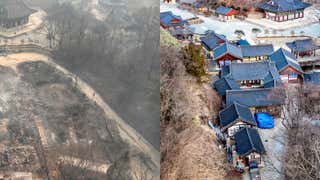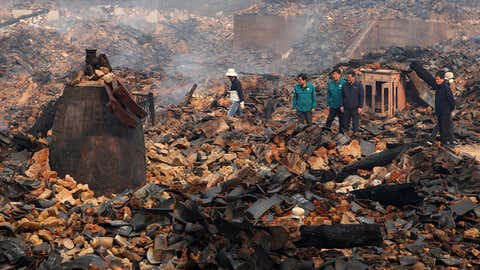
South Korea Wildfires Consume Ancient Temples
The death toll rose to 28 Thursday as wildfires continued to burn aggressively in South Korea. The fires have burned up more than 300 structures and forced 37,000 people to evacuate, according to officials.
The New York Times reported that nearly 30 wildfires were burning in the country. The blazes, which have consumed nearly 140 square miles, were fueled by strong winds and were classified as the worst South Korea has ever seen, the Associated Press reported. Thousands of personnel were working against the fires, using dozens of helicopters and other equipment.
Rain was forecast for later Thursday, but with less than a quarter of an inch expected, it likely won't make a huge impact on the wildfires.
One of the victims included a pilot who died after a helicopter crashed as it aided in the firefight in the town of Uiseong in the southeastern region of South Korea. At least 26 other people were injured during the crash, though there were no other crew members in the aircraft.
(MORE: Wildfires Explode In Size In South Carolina; North Carolina Fires Still Uncontained)
Four firefighters and government workers were killed in Sancheong on Saturday when they became trapped by wind-driven flames, according to officials.
The AP reported that many of the victims are likely elderly residents who were not able to escape quickly or refused to evacuate.
The fire in Uiseong destroyed 20 of the 30 structures at Gounsa, an ancient Buddhist temple complex said to have originated in the 7th century. According to the Korea JoongAng Daily, some artifacts were saved from the fire, including a seated stone Buddha, which is designated a treasure by the state.

The same fire was also threatening the historic Hahoe Folk Village in Andong, a UNESCO World Heritage site. All residents of the village were urged to evacuate Tuesday evening and emergency crews worked to protect the site from igniting.
Another 1,000-year-old temple in the Uiseong region, Unramsa, was destroyed as well, according to Reuters. Relics were also salvaged from the site before the fires took hold.
Several other southeastern cities and towns were under evacuation orders as well, and authorities evacuated 500 inmates from a detention center in Cheongsong. Some of the hardest-hit areas include Andong city, the city of Ulsan and the counties of Uiseong and Sancheong.
South Korea’s acting President Han Duck-soo said that the wildfires, which began on March 21, were causing worse damage than many wildfires the country has experienced in the past.
(MORE: Social Media Is Revolutionizing Disaster Response, Expert Says)
“Damages are snowballing,” he said in a televised address. “There are concerns that we’ll have wildfire damages that we’ve never experienced, so we have to concentrate all our capabilities to put out the wildfires in the rest of the week.”
The Korea Forest Service wildfire warning remains at its highest level, requiring more workers to be assigned to the incident by local governments, entry to forests and parks to be restricted and the recommendation for the military to postpone any live-fire exercises.
Several of the fires are suspected to be caused by human error, such as residents burning overgrown grass from family tombs. The AP reported that sparks from welders could have ignited some of the blazes as well.
The wildfires have exhibited "the reality of [the] climate crisis," according to Lee Han-kyung, deputy head of the government's disaster response center.







